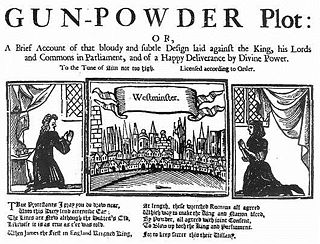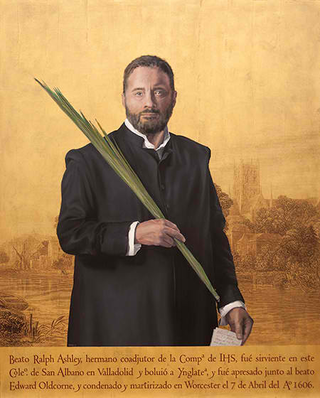
The Gunpowder Plot of 1605, in earlier centuries often called the Gunpowder Treason Plot or the Jesuit Treason, was an unsuccessful attempted regicide against King James VI of Scotland and I of England by a group of English Roman Catholics, led by Robert Catesby, who considered their actions attempted tyrannicide and who sought regime change in England after decades of religious persecution.
William Habington was an English poet.

William Parker, 13th Baron Morley, 4th Baron Monteagle, was an English peer, best known for his role in the discovery of the Gunpowder Plot. In 1605 Parker was due to attend the opening of Parliament. He was a member of the House of Lords as Lord Monteagle, the title on his mother's side. He received a letter; it appears that someone, presumably a fellow Catholic, was afraid he would be blown up. The so-called Monteagle letter survives in the National Archives, but its origin remains mysterious.
A priest hole is a hiding place for a priest built in England or Wales during the period when Catholics were persecuted by law. Following the accession of Queen Elizabeth I to the throne in 1558, there were several Catholic plots designed to remove her, and severe measures, including torture and execution, were taken against Catholic priests. From the mid-1570s, hides were built into houses to conceal priests from priest hunters. Most of the hides that survive today are in country manor houses, but there is much documentary evidence, for example in the Autobiography and Narrative of the Gunpowder Plot of John Gerard, of hides in towns and cities, especially in London.

Sir Thomas Habington or Abington (1560–1647) was a Catholic English antiquary. He is particularly remembered as an early county historian of Worcestershire, although little of his work was published in his lifetime.

Ralph Ashley, SJ was an English Jesuit lay brother who became involved with the aftermath of the Gunpowder Plot. He is a Catholic martyr, beatified in 1929.

Edward Oldcorne alias Hall was an English Jesuit priest. He was known to people who knew of the Gunpowder Plot to destroy the Parliament of England and kill King James I; and although his involvement is unclear, he was caught up in the subsequent investigation. He is a Roman Catholic martyr and was beatified in 1929.

Hindlip Hall is a stately home in Hindlip, Worcestershire, England. The first major hall was built before 1575, and it played a significant role in both the Babington and the Gunpowder plots, where it hid four people in priest holes. It was Humphrey Littleton who told the authorities that Edward Oldcorne was hiding here after he had been heard saying Mass at Hindlip Hall. Four people were executed and the owner at that time barely escaped execution himself due to the intercession of Lord Monteagle.
Humphrey Littleton, or Humphrey Lyttelton, was a member of the Lyttelton family, who was executed for his involvement in the Gunpowder plot. Robert Wintour and Stephen Lyttelton who had escaped from the fight at Holbeche House were captured at Hagley Park on 9 January 1606 despite Littleton's protests that he was not harbouring anyone. It was Littleton who told the authorities that Edward Oldcorne was hiding at Hindlip Hall after he had given him mass. Wintour, Oldcorne, and both Littletons were all executed.

Hallow is a village and civil parish beside the River Severn, about 2 miles (3.2 km) north-west of Worcester in Worcestershire. The village is on the A443 road that links Worcester with Holt Heath. Hallow has a public house, a post office and a Church of England primary school.

Worcester Castle was a Norman fortification built between 1068 and 1069 in Worcester, England by Urse d'Abetot on behalf of William the Conqueror. The castle had a motte-and-bailey design and was located on the south side of the old Anglo-Saxon city, cutting into the grounds of Worcester Cathedral. Royal castles were owned by the king and maintained on his behalf by an appointed constable. At Worcester that role was passed down through the local Beauchamp family on a hereditary basis, giving them permanent control of the castle and considerable power within the city. The castle played an important part in the wars of the 12th and early 13th century, including the Anarchy and the First Barons' War.
Anne Vaux was a wealthy Catholic recusant.
Edward Habington, Abington, or Abingdon (1553?–1586), was one of the conspirators in the Babington Plot.
Edward Parker, 12th Baron Morley was an English peer, Lord of Morley, Hingham, Hockering, &c., in Norfolk, the son of Henry Parker, 11th Baron Morley and Lady Elizabeth Stanley. His second daughter was Frances Danby.

Sir Henry Bromley was an English landowner and politician who sat in the House of Commons at various times between 1584 and 1604. He was twice imprisoned for his political activities, the second and most serious occasion in the aftermath of the Essex Rebellion. Restored to favour in the Jacobean period, he was vigorous in suppressing the Gunpowder Plot.
Dorothy Kitson, later Dorothy, Lady Pakington, was the daughter of Sir Thomas Kitson, a wealthy London merchant and the builder of Hengrave Hall in Suffolk. Her first husband was Sir Thomas Pakington, by whom she was the mother of Queen Elizabeth I's favourite, Sir John "Lusty" Pakington. After Sir Thomas Pakington's death, she married Thomas Tasburgh. She was one of the few women in Tudor England to nominate burgesses to Parliament and to make her last will while her husband, Thomas Tasburgh, was still living. Her three nieces are referred to in the poems of Edmund Spenser.
Robert Pakington was a London merchant and Member of Parliament. He was murdered with a handgun in London in 1536, likely the first such killing in the city. His murder was later interpreted as martyrdom, and recounted in John Foxe's Acts and Monuments. He was the grandfather of Queen Elizabeth I's favourite, Sir John "Lusty" Pakington.

Meriel Lyttelton or Littelton was an English aristocrat with extensive family and court connections. She was a daughter of Sir Thomas Bromley and Elizabeth Fortescue. The MP for Worcestershire Thomas Bromley was her nephew.
Dorothy Bradbelt or Broadbelte was an English courtier, a woman of the bedchamber to Elizabeth I, described as the "Queen's bedfellow".
Mary Habington or Abington, néeParker was an English recusant. Antiquarian writers thought that she was the author of the anonymous letter to her brother William Parker, 4th Baron Monteagle which warned of the Gunpowder Plot. This theory is dismissed by modern historians. She sheltered a number of Catholic priests and recusants at her Worcestershire home Hindlip Hall.










